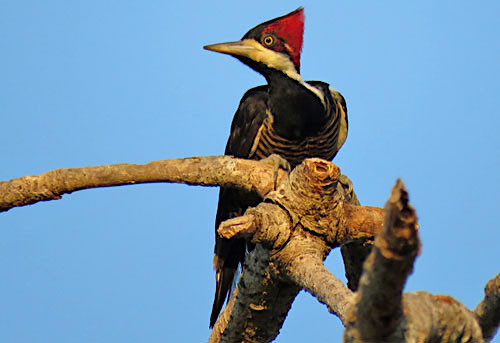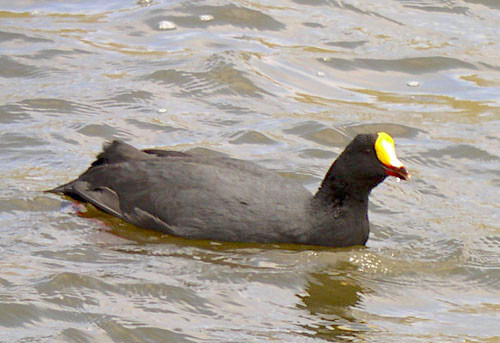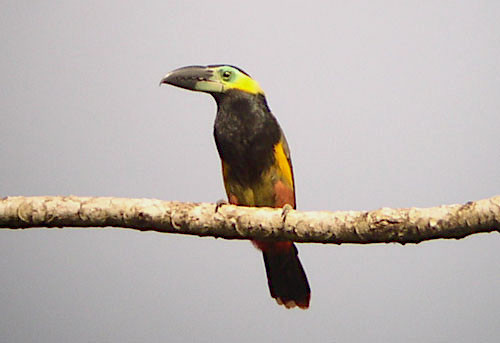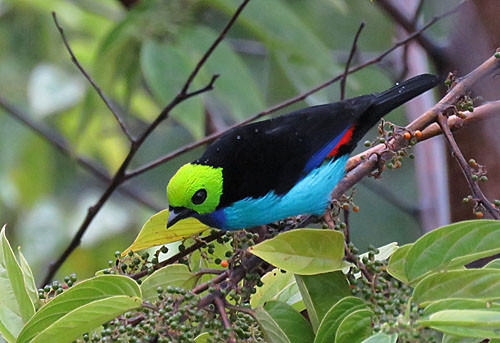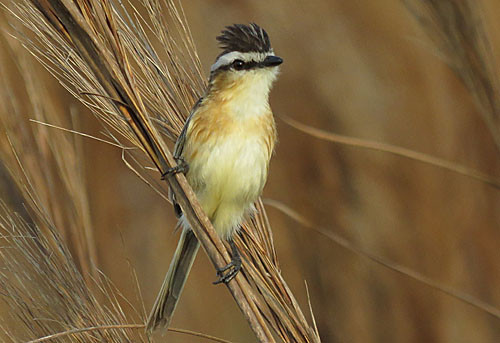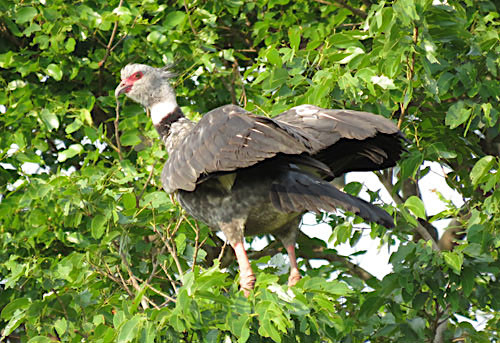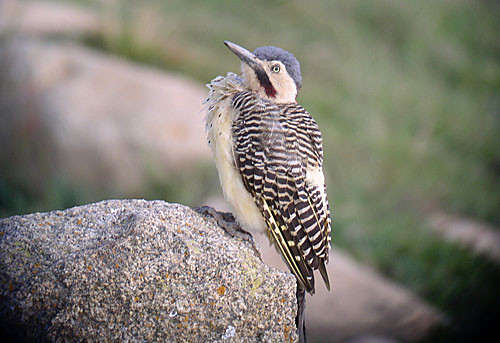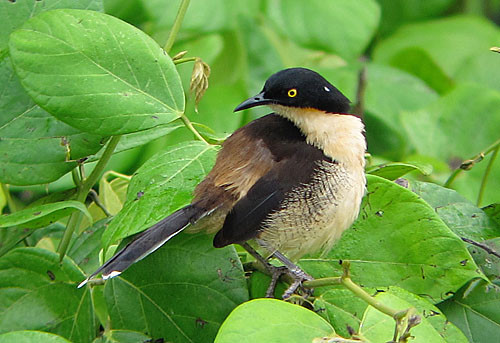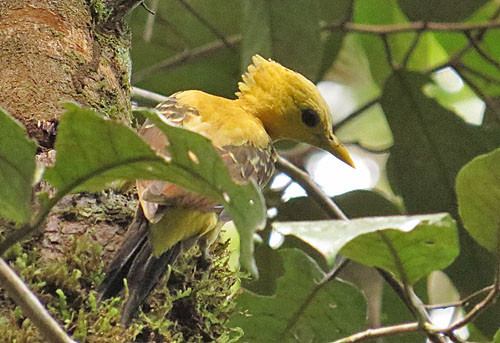 Of all the New World woodpeckers, Cream-colored Woodpecker is one of the most striking. Photo: Rich Hoyer
Of all the New World woodpeckers, Cream-colored Woodpecker is one of the most striking. Photo: Rich Hoyer Bolivia is a large country with many ecoregions, and this companion to our classic Bolivia tour allows you to see even more of it and the wonderful birds that call it home. We’ll visit four regions of radically different ecosystems, all farther north than our other tour. Starting with the Lake Titicaca area, we’ll bird its shores then cross the northern Andes and descend through the cloud forests on our way to the dry interior valley of Apolo, which has a whole host of special birds. We’ll then return to La Paz to take a short flight to the Amazonian lowlands where we’ll spend some time at one of Bolivia’s few ecolodges, located on the outermost ridge of the Andes—low enough to have some classic Amazonian species yet high enough to offer some respite from the tropical heat. Finally, we’ll take a private air taxi to Barba Azul Nature Reserve, a remote station located in the Llanos de Moxos, a region of seasonally flooded tropical savanna and gallery forest. After two days at bird-filled Barba Azul, famous for its conservation importance for the Blue-throated Macaw, we’ll finish with a day in Trinidad and a short internal flight to Santa Cruz de la Sierra.
Day 1: The tour begins this evening at our La Paz hotel.
Day 2: After a relaxed morning start, we’ll have an easy day to acclimate to the elevation and recover from overnight flights, but we’ll still see some exciting birds in the process, among which could be Titicaca Grebe (found only in this lake’s basin), Yellow-winged Blackbird, Many-colored Rush-Tyrant, and Wren-like Rushbird. A detour to the valley of Sorata may result in our finding the endemic Berlepsch’s Canastero and Black-hooded Sunbeam. Night at Lake Titicaca.
Day 3: If necessary, we’ll make some more birding stops along Lake Titicaca and at nearby marshes to look for waterfowl, such as Andean Goose and Yellow-billed Pintail, Chilean Flamingos, and migrant shorebirds before we start working our way into the drier, upland habitats of the Andes. Ovenbirds such as the Slender-billed Miner and tyrants such as Ochre-naped Ground-Tyrant could be found on the short grass tundra-like puna, while various small ponds and lakes should have Giant Coot, Crested Duck, and many other fascinating species. Well then cross a high pass and arrive at a stopping point part way down the Andean slope. Night in Charazani.
Day 4: We’ll complete our drive to Apolo today, passing through some mid-elevation cloud forests that are full of interesting birds. At the higher elevations, we’ll listen for the ethereal songs of Andean Solitaires, keeping our eyes on the sky for the rare White-throated Hawk and much more likely Andean Condor. As the day progresses, we’ll visit lower stretches of cloud forest with more subtropical affinities, and possibilities here include Many-spotted Hummingbird, Slaty Gnateater, Montane Foliage-gleaner, Upland Antshrike, White-rumped Hawk, the recently split Yungas Warbler, and many more. We’ll arrive at our lodging in the early evening. Night in Apolo.
Days 5–6: We’ll spend two days in this interior valley in the rain shadow of the Andes’ outlying ridges. Dry areas like this in an otherwise rain-drenched eastern slope are quite rare and host birds with isolated distributions. One of the most famous recent rediscoveries here is the endemic and far-removed subspecies of Swallow-tailed Cotinga, which some split as the Palkachupa Cotinga. We’ll make a special effort for it and also look for the rare Green-capped Tanager, a subtle beauty with a tiny distribution. In the drier areas likely species include White-eared Puffbird, Blue-crowned Trogon, Red-winged Tinamou, and Sapphire-spangled Emerald. In the taller seasonally dry forests within the Madidi National Park’s buffer zone we’ll search for the enigmatic and recently described Inti Tanager, along with White-bellied Pygmy-Tyrant, Black-bellied Antwren, and the very range-restricted Ashy Antwren. Arboreal Brasiliopuntia cacti and trees festooned with bromeliads and epiphytic staghorn ferns give this forest a fascinating and alluring aspect. Nights in Apolo.
Day 7: We’ll retrace our steps back towards La Paz, breaking the long drive in half in order to bird the moist cloud forests along the main road once again. We’ll be certain to pick up many species we missed on the way down, which could include Amazonian Umbrellabird, Yungas Warbler, and Rufous-booted Racket-tail. Night in Charazani.
Day 8: We’ll spend the early morning just outside of this high-elevation town to bird the edges of the dry scrub below the puna zone where Puna Tapaculo and Andean Hillstar are among the many possibilities. Then we’ll work our way over the broad, high pass, where we’ll concentrate on picking up some species that we may have missed on the first drive through here, with Gray-breasted Seedsnipe, Bright-rumped Yellow-Finch, Buff-breasted Earthcreeper just some of the possibilities. We’ll complete the day with a drive to La Paz. Night in La Paz.
Day 9: This morning we’ll take a 30-minute flight to Rurrenabaque, Bolivia’s gateway to Amazon Basin. From there we’ll transfer by road to the ecolodge that will be our home for the next four nights, stopping to look for birds along the way if we have time. A pond by the road is a great place to check for Hoatzin, while we’ll likely be distracted by toucans and aracaris perched in roadside trees, Roadside Hawks sitting right where they belong, family groups of Smooth-billed Anis in hedgerows, and Red-breasted Meadowlarks on fences. We’ll arrive at our lodge in time for lunch and enjoy the lovely view of the deeply layered forest right outside the dining hall. A jungle lodge on an outlying ridge of the Andes, Sadiri is a rarity in Bolivia. Amidst this perfect habitat we’ll enjoy leisurely birding while paying special attention to the range-limited species found here. The recently described Yungas Tyrannulet is unlikely to be found on any other tour’s itinerary, but more common and colorful birds such as Starred Wood-Quail and Paradise Tanager will be just as delightful. Mixed flocks pass right by our cabins, and an excellent system of forest trails and a little-traveled road pass through beautiful, pristine habitat full of potential. Night at Sadiri Lodge.
Days 10-11: We’ll have two full days of birding the trails and roads at Sadiri, allowing for afternoon siestas and chances to sit and watch the hummingbird feeders, as well a taking evening owling walks with possibilities of witnessing other nocturnal creatures such as Paca and numerous frogs. Nights at Sadiri Lodge.
Day 12: After some early morning birding at Sadiri, we’ll drive to the frontier town of Santa Rosa de Yacuma. Along the way we’ll pass by some extensive marshes and exquisite habitat, and driving nonstop will be impossible. We’ll likely see Snail Kite, Black-collared Hawk, Limpkin and many other water birds along the way, and we’ll arrive in time for our chartered air taxi. From Santa Rosa we take a 30-minute flight, passing over the enchanting landscapes of marshes, lakes, pastures, and grasslands of the Llanos de Moxos. We’ll arrive at Barba Azul Nature Reserve in time for lunch, take a siesta, and then in the afternoon make our first outing, during which we’ll likely see our first Blue-throated Macaws. Night at Barba Azul Nature Reserve.
Day 13-14: We’ll have two full days based at the reserve. We’ll prioritize several specialties, especially the namesake of the reserve, the extremely local Blue-throated Macaw. The story of the discovery of the Blue-throated Macaw’s distribution and its ongoing conservation is well known but can’t be told often enough. If not for the efforts of several conservationists in Bolivia, the species could very well be extinct in the wild, and our visit will help support the efforts to ensure its survival. There are actually six species of macaws possible here, as well as many other birds found in the tropical savanna and gallery forests, and we’ll search for specialties such as Cock-tailed Tyrant, Sharp-tailed Tyrant, Streamer-tailed Tyrant, Black-masked Finch, Long-winged Harrier, and Chimango Caracara. This region is so filled with birds, each day’s bird list will likely exceed 125 species with little effort. Nights at Barba Azul Nature Reserve.
Day 15: After a final morning of birding at the reserve we’ll continue via private air taxi to Trinidad, with some afternoon birding near town. We’ll look for the unusual and highly localized vireo that has been provisionally placed with Gray-eyed Greenlet, check the lake shore for water birds, and likely see Scarlet-headed Blackbird in the nearby marshes. Night in Trinidad.
Day 16: We’ll have most of the day based out of Trinidad to look for any birds missing from our list, and there are a few specialties more easily found here than elsewhere on our itinerary. Unicolored Thrush, an elusive endemic, is one of the more remote possibilities. If we’ve missed the Blue-throated Macaw due to unforeseen circumstances, there’s a discrete breeding population within driving distance that will be our priority. The Velvet-fronted Grackle and Plain Softtail that occur in this part of Bolivia are often considered worthy of specific status, so we’ll look for them as well. In the afternoon we’ll take a commercial flight to Santa Cruz. Night in Santa Cruz de la Sierra.
Day 17: The tour ends this morning with transfers to the international airport in Santa Cruz de la Sierra.
Updated: 27 September 2023
Prices
- 2026 Price Not Yet Available
Notes

Questions? Tour Manager: Greg Greene. Call 1-866-547-9868 (US or Canada) or (01) 520-320-9868 or click here to email.
* Tour invoices paid by check carry a 4% discount. Details here.
Maximum group size seven with one leader.
**The single occupancy supplement indicated above covers only those sites where single lodging is available. See the Accommodations section of the Tour Information page for details.

